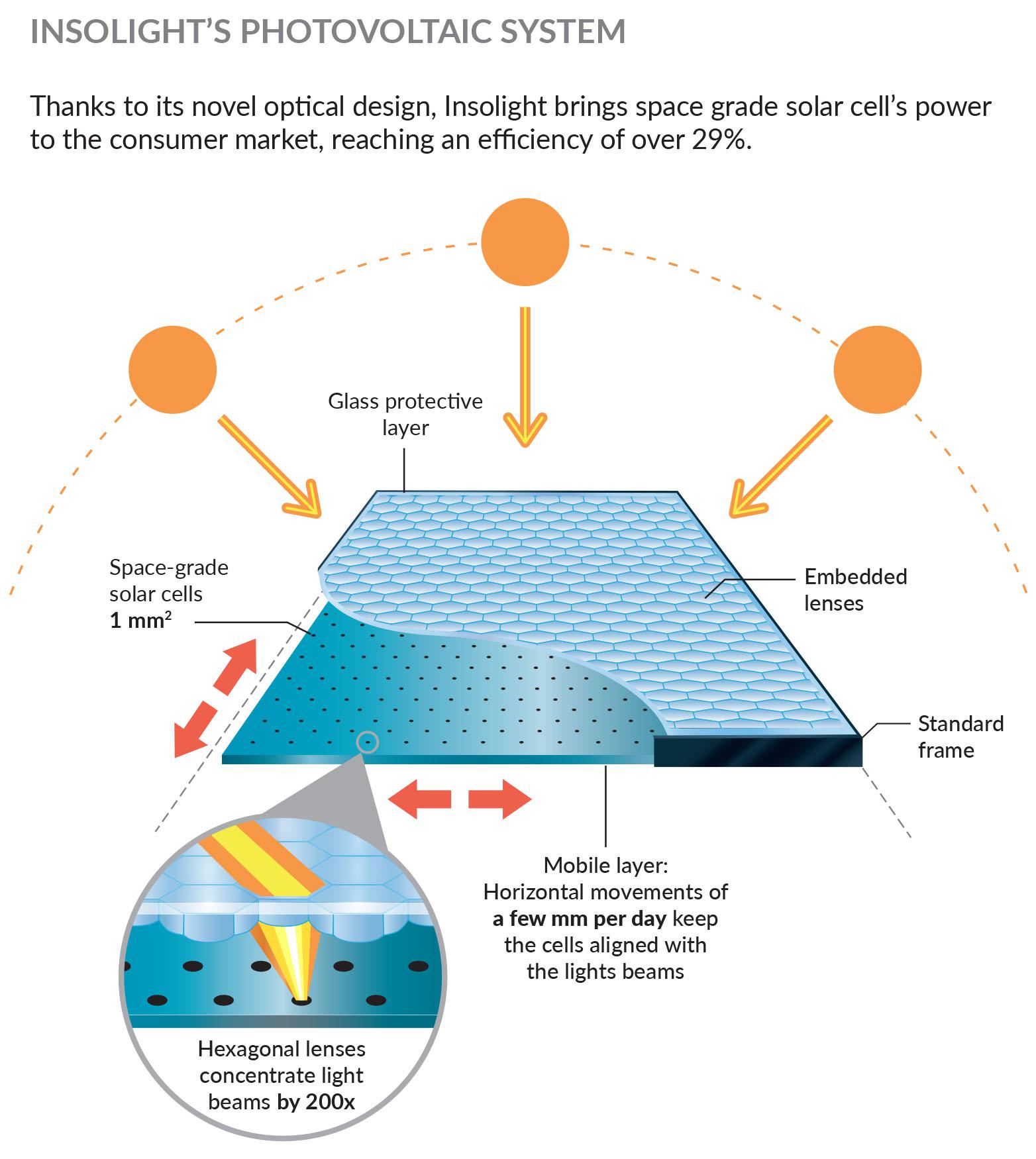(New residential solar panels deliver record-breaking efficiency)
2019/2/19 欧州連合(EU) CORDIS

・ EPFL のスピンオフ企業である Insolight が、エネルギー変換効率 29%の住宅用薄型太陽光発電システムを開発。
・ 同太陽光発電システムでは、オプティカルシステム(特許取得済み)が衛星で使用される小型PVセルに太陽光を集光する。このような PV は高効率ではあるが高価であるため、オプティカルレンズを配置する保護ガラスを開発してコストの低減を図った。
・ 同オプティカルレンズは、高性能 PV セルの狭小な面積(太陽光パネル表面に占める面積は 0.5%以下)に太陽光を数百倍集光する。また、日中に太陽光を水平に数 mm 毎に追跡する機構を設計した。
・ 太陽光パネル表面でセルの占める面積が極僅かであるため、同太陽光発電システムは従来の太陽光パネルの上に設置することも可能。このようなハイブリッド・アプローチは、曇りや集光が少ない場合に特に有効と考える。同システムの外観や設置方法は、一般的なルーフトップ用パネルと変わらない。
・ 2 年前に研究室での試験にて同システムのエネルギー変換効率 36%を達成して以来、変換効率 29%(スペイン・Institute of Solar Energy at the Technical University of Madrid (IES-UPM)にて認証)での量産に向けた標準化を進めている。また、EPFL のパイロットサイトのルーフトップにて同システムを 1 年間試験した結果、熱波、嵐や冬季の気候を通じて継続した作動を確認した。
・ 晴天の多い地域において、同システムは家庭の光熱費を最大で 30%削減し、従来の太陽光発電ソリューションに比して優れた投資利益率を提供。現在、太陽光パネルメーカー数社と技術供与について協議中。同社のシステムは標準的なパネル製造プロセスに数工程を追加するだけで製造できる。 2022 年に上市予定。
URL: https://actu.epfl.ch/news/new-residential-solar-panels-deliver-record-breaki/
(関連情報) Insolight ウェブサイト URL: https://insolight.ch/
<NEDO海外技術情報より>
The solar panels developed by startup Insolight boast an impressive 29% yield – a record for the retail market. These systems, which have now been standardized for mass production, contain lenses that focus sunlight on tiny high-yield photovoltaic cells, employing what is a pioneering approach for the solar-power industry.
All rooftop solar panels look pretty much the same from the outside: same size, same thickness and even the same installation system. But on the inside, the solar panels developed by EPFL spin-off Insolight stand apart. They deliver yields of 29% – nearly twice as much as the others currently on the market (which have yields of 17–19% ). Insolight’s panels, which were recently tested by an independent lab, use a patented optical system that concentrates sunlight on a kind of miniature photovoltaic cell normally used in satellites
Boosting efficiency while keeping a lid on costs
Studies have shown that the average yield on commercial solar panels has increased by just 3.5 percentage points since the 2000s and seemed to be reaching a plateau. But Insolight’s three founders – Mathieu Ackermann, Laurent Coulot and Florian Gerlich – wanted to push yields further and decided to try  something radically different: build residential solar panels that employ the same kinds of cells used in satellites, which are very efficient but also very expensive. To keep costs down for the retail market, they developed a protective glass on which optical lenses can be placed that concentrate sunlight by some 100x and direct it to the tiny surface of the high-performance cells. That means the cells need to take up less than 0.5% of the solar panel surface. The founders also designed a mechanism that can move the cells horizontally by a few millimeters each way in order to follow sunlight throughout the day.
something radically different: build residential solar panels that employ the same kinds of cells used in satellites, which are very efficient but also very expensive. To keep costs down for the retail market, they developed a protective glass on which optical lenses can be placed that concentrate sunlight by some 100x and direct it to the tiny surface of the high-performance cells. That means the cells need to take up less than 0.5% of the solar panel surface. The founders also designed a mechanism that can move the cells horizontally by a few millimeters each way in order to follow sunlight throughout the day.
Because the cells occupy just a tiny fraction of the solar panel surface, Insolight’s system can even be installed on top of conventional solar panels to boost their yields. “This hybrid approach is particularly effective when it’s cloudy and the sunlight is less concentrated, since it can keep generating power even under diffuse light rays,” says Ackermann, Insolight’s CTO.
The ultra-thin system has the same look and shape as regular rooftop panels and can be installed in the same way. “The real challenge for the retail market is to increase yields without pushing costs too high, while keeping the equipment both robust and easy to install,” says Coulot, the firm’s CEO.
Insolight’s technology first set a record in lab tests two years ago, when it achieved a yield of 36%. The system has since been standardized for mass production with a 29% yield – far ahead of competitors’ 17–19% yield – as confirmed in tests by the Institute of Solar Energy at the Technical University of Madrid (IES-UPM).
The system was also tested for a full year on rooftops at an EPFL pilot site. “Our panels were hooked up to the grid and monitored continually. They kept working without a hitch through heat waves, storms and winter weather,” says Ackermann proudly.
Cutting energy bills by 30%
According to the founders, Insolight’s solar panels offer a better return on investment than competing solutions. “Our technology can cut household energy bills by up to 30% in sunny regions,” says Coulot. This calculation – performed according to standard industry practice – factors in the panels’ cost, useful life and yield, as well as local power costs, weather conditions, borrowing costs, and maintenance and cleaning costs.
The firm’s three founders met at EPFL and established their company at the school’s Innovation Park. Today they are in talks with several solar panel manufacturers to license their technology. “Making our panels entails a few additional steps during the assembly stage. These steps could be tacked on to the end of standard production processes,” says Coulot. The company plans to launch its first product on the market in 2022.
References
1 Fraunhofer Institute for Solar Energy Systems ISE, Photovoltaics Report, February 2018
2 Crystalline PV efficiency: highest laboratory cells vs. average commercial modules. Data: Christensen (1985); Maycock (1994, 2002); Grubb and Vigotti (1997); Menanteau (2000); Green et al. (2001).
Author: Cécilia Carron
Source: Mediacom


